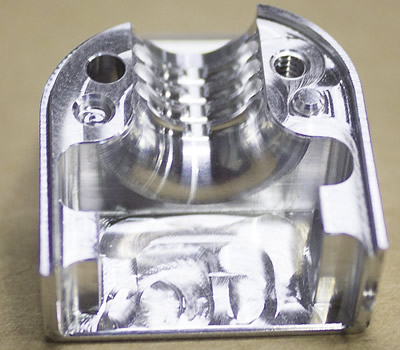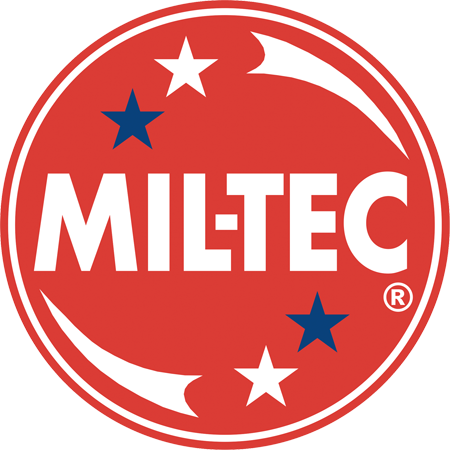
END USER: Toolcraft Inc., (360) 794-5512, www.tcprecision.com
SOLUTION PROVIDER: Mil-Tec Inc., (800) 564-5832, www.miltecusa.com
CHALLENGE: Reduce cycle time when machining an aluminum part.
SOLUTION: A progressive form tool applied on a horizontal machining center.

Sometimes a more-complex cutting tool simplifies part production by streamlining the machining operation. Toolcraft Inc. realized this when machining a 6061 aluminum medical part.
The Monroe, Wash., manufacturer was applying an 1⁄8" (3.175mm) ballnose endmill to rough the radius of the part and then finishing with a 1⁄16" (1.59mm) ballnose endmill, said Brian Laulainen, shop supervisor. “To scrub the radius would take 20 or 30 passes, going back and forth on that radius to knock the sharp corners down,” he said about the finishing operation.


Mil-Tec produced this progressive form tool to enable Toolcraft to replace two ballnose endmills and significantly reduce the cycle time when machining a 6061 aluminum part (below). Images courtesy Mil-Tec.


Finishing took place on a compact machining center with a 24,000-rpm spindle, he added. The bar-stock workpiece was then parted off before being manually deburred with a Scotch-Brite abrasive wheel.
The parts, which are nickel-plated, had a surface finish of about 125 rms. “Because it’s just a gripper feature for a cable,” he said, “it wasn’t important to have a good finish.”
Because Toolcraft produces about 25,000 of the parts per year, Laulainen pointed out that it needed to significantly reduce the cycle time. Toolcraft determined that it could achieve that reduction by applying one form tool on a horizontal machining center and eliminate the secondary operation.
Laulainen designed a form tool and submitted it to a Seattle toolmaker, but that company did not have the proper equipment, such as the grinding wheel pack, to accomplish the job. “It was too difficult of a tool for them to do,” he added.
That company recommended that Toolcraft try Mil-Tec Inc., Lehigh Acres, Fla. Mil-Tec accepted the project and redesigned the form tool to make it easier to produce. Although Mil-Tec reports that it has traditionally been known for its indexable mills, the company makes a full line of solid-carbide tools.
One consideration when designing the tool was the need to minimize cutting pressure because the workpieces are held standing up in a dovetail fixture. According to Laulainen, such a workholding arrangement lacks rigidity. “If you had a lot of cutting pressure, you would just push that part back and forth,” he said, adding that the result would be inconsistent part sizes. The tolerance for the part’s diameter is ±0.002" (±0.051mm).
“The part being machined was aluminum, so we built the tool as a progressive form tool so that it didn’t generate too much tool pressure,” said Mark Wortsman, director of rotary tool grinding for Mil-Tec. “The tool grinding software and technology has evolved, so more exotic shapes can be produced to make the machining of complex forms much easier and cleaner.”
In the HMC, Laulainen explained, Toolcraft runs two pallets of parts per cycle start, and each pallet has six strips of parts, with seven workpieces per strip, or three-and-a-half assemblies. The tool runs at a cutting speed of 490 sfm (149.4 m/min.) and a feed rate of 5 ipm (127 mm/min.).
The cycle time for machining the 42 assemblies is just under 4 hours, Laulainen said. Compared to the previous process with two cutting tools, the current process reduces the cycle time for each assembly by about 69 seconds. “We knocked off 46 minutes per cycle start,” he said.
Although part finish is not an issue, Laulainen noted the new tool imparts a finish that is “probably better than 32 and closer to 16 rms.” In addition, the parts don’t require deburring, and tool life for the uncoated form tool is significantly longer than the 2,000 to 3,000 parts Toolcraft experienced with the coated ballnose endmills.
“We’ve maybe made up to 15,000 parts and haven’t changed the tool yet,” Laulainen said.
Contact Details
Related Glossary Terms
- abrasive
abrasive
Substance used for grinding, honing, lapping, superfinishing and polishing. Examples include garnet, emery, corundum, silicon carbide, cubic boron nitride and diamond in various grit sizes.
- cutting speed
cutting speed
Tangential velocity on the surface of the tool or workpiece at the cutting interface. The formula for cutting speed (sfm) is tool diameter 5 0.26 5 spindle speed (rpm). The formula for feed per tooth (fpt) is table feed (ipm)/number of flutes/spindle speed (rpm). The formula for spindle speed (rpm) is cutting speed (sfm) 5 3.82/tool diameter. The formula for table feed (ipm) is feed per tooth (ftp) 5 number of tool flutes 5 spindle speed (rpm).
- endmill
endmill
Milling cutter held by its shank that cuts on its periphery and, if so configured, on its free end. Takes a variety of shapes (single- and double-end, roughing, ballnose and cup-end) and sizes (stub, medium, long and extra-long). Also comes with differing numbers of flutes.
- feed
feed
Rate of change of position of the tool as a whole, relative to the workpiece while cutting.
- fixture
fixture
Device, often made in-house, that holds a specific workpiece. See jig; modular fixturing.
- grinding
grinding
Machining operation in which material is removed from the workpiece by a powered abrasive wheel, stone, belt, paste, sheet, compound, slurry, etc. Takes various forms: surface grinding (creates flat and/or squared surfaces); cylindrical grinding (for external cylindrical and tapered shapes, fillets, undercuts, etc.); centerless grinding; chamfering; thread and form grinding; tool and cutter grinding; offhand grinding; lapping and polishing (grinding with extremely fine grits to create ultrasmooth surfaces); honing; and disc grinding.
- grinding wheel
grinding wheel
Wheel formed from abrasive material mixed in a suitable matrix. Takes a variety of shapes but falls into two basic categories: one that cuts on its periphery, as in reciprocating grinding, and one that cuts on its side or face, as in tool and cutter grinding.
- inches per minute ( ipm)
inches per minute ( ipm)
Value that refers to how far the workpiece or cutter advances linearly in 1 minute, defined as: ipm = ipt 5 number of effective teeth 5 rpm. Also known as the table feed or machine feed.
- machining center
machining center
CNC machine tool capable of drilling, reaming, tapping, milling and boring. Normally comes with an automatic toolchanger. See automatic toolchanger.
- tolerance
tolerance
Minimum and maximum amount a workpiece dimension is allowed to vary from a set standard and still be acceptable.







